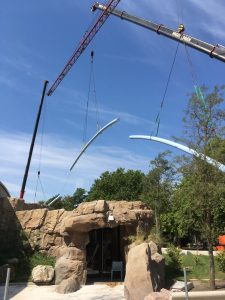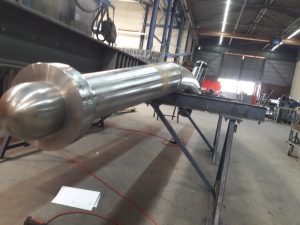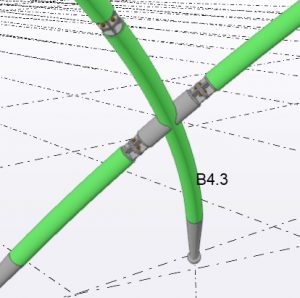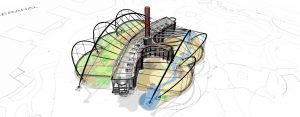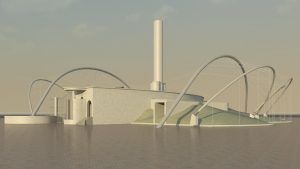Gelada verblijf Blijdorp

| Categorie | Sport en recreatie |
|---|---|
| Jaar | 2020 |
| Land | Benelux |
| Organisatie | Vic Obdam |
| Auteur | Thijmen Blankendaal |
| Co-auteurs | Dilu Beenker |
| Cliënt | Koninklijke Woudenberg Ameide B.V. |
| Plaats van constructie | Rotterdam |
| Tags |
Algemene Projectomschrijving:
Eind 2018 is het nieuwe verblijf van de gelada’s officieel geopend. Via het geheel gerenoveerde rijksmonument en langs de netconstructie sta je bijna oog in oog staat met de grazende gelada’s (apensoort uit Ethiopië). Waar voorheen leeuwen en tijgers leefden, kun je nu de galada’s bewonderen. Diergaarde Blijdorp is de enige tuin in Nederland waar deze bijzondere apen zijn te bewonderen.
Bij de renovatie is rekening gehouden met het rijksmonument ontwerp van Sybold van Ravesteyn dat dateert uit de jaren 1939-1941. Er is zoveel als mogelijk gerenoveerd naar de oorspronkelijke staat rekening houdend met de nieuwste inzichten op het gebied van dierenwelzijn.
Beschrijving staalconstructie en/of gebruik van staal:
Al komen de bezoeker voornamelijk om de galada’s te bewonderen, is er voor de bezoeker met een bouwkundige interesse ook een prachtige constructie te bewonder. De constructie van 66 ton is gemaakt van stalen bogen die door middel van RVS kabels en netten samen met het rijksmonument een prachtig eigentijds verblijf creëert. Door keuze van bogen met netten blijft het monumentale karakter zichtbaar en behouden.
De constructie is opgebouwd uit een tweetal grote bogen en een vijftal kleine. Elke boog wordt op de horizontale positie gehouden door RVS netten en staalkabels Ø12 en Ø16 mm bevestigd aan de constructie van het monumentale gebouw en de fundering. In de verticale richting staan de bogen verankerd in een gegoten en gedraaid kogel scharnier.
De grote bogen van maar liefst 61 en 40 meter overspanning zorgen voor een open buitenruimte zonder beperkingen van kolommen. De vijftal kleinere bogen met een overspanning van circa 22 meter aan de rand van het verblijf zorgen samen met de RVS staalkabels en netten voor de omsluiting van het verblijft.
De constructie maakt een buitenverblijf mogelijk waar je van elk hoek galada’s op korte afstand kan aanschouwen. De grootte boogoverspanning maak het mogelijk dat er met namaak rotsen, winterharde struiken en bomen die lijken op de natuurlijke beplanting uit het Ethiopisch laagland de natuurlijke habitat wordt nagebootst.
Bijzondere aspecten bouwkundig concept / ontwerp:
Door de bijzondere stalen boogconstructie staat het monumentale gebouw volledig in het zicht. Daarnaast de open ruimte vrij van kolommen de perfectie ruimte voor het namaken van de natuurlijke habitat.
Bijzondere constructieve slimmigheden / detailleringen:
In het ontwerp is veel aandacht besteed aan de het opdeling en de verankering van de stalen boogspanten. De stalenboogspanten bestaan uit buisprofielen varieerend van 355/20 voor de grootst overspaning tot 244,5/10 voor de kleinste overspanningen. Middels staalkabels worden de bogen op positie gehouden en met een 3 laags natlaksysteem is de constuctie beschermd tegen de weersinvloeden.
Delingen
De afmeting van de boog op locatie is te groot om in één deel over de weg te transporteren. Deling zijn om deze reden nodig maar niet gewens. Er is gekozen om de deling binnen het pofiel te realiseren waarna de deling wordt afgewerk met dun gewalste staalplaat. Zo is het strakke uiterlijkt van één complete boog behoudengbleven.
Verankering boogspanten
De boogspanten dragen de kracht af middels gedraaide trompstukken in een gegoten stalenvoetstuk. De krachten en benodigde stijfheid samen met het kleine beschikbare opppervlak in de schaal van het voetstuk voor de krachtsinleiding was dermate kritisch dat een massief gedraaid stalentrompstuk de beste oplossing bood.
Bijzondere aspecten uitvoering:
De verankering van de bogen bestaan uit 12 gegoten voetstukken in 6 verschillende variaties. Iedere voetstuk heeft een eigen positie en hoekverdraaiing. Het instorten van de gegoten voetstukken is nauwkeurig werk dat zeer bepalend is voor de passing van de stalenboogspanten.
Door de complexe vorm en samenhang tussen de bogen onderling is het nodig de bogen tijdelijk te ondersteunen met hulpstaal, spanbanden en maar liefst 3 telekranen.
De funderingsbalken zijn onderling gekoppeld en gespannen door Dywidag Tei Rod Gewi Ø40. Dit is nodig om de horizontale verplaatsing op te vangen die wordt veroorzaakt door krachtsinleiding van de boogspanten.
Bijzondere functionele aspecten van het bouwwerk:
Met het oog op duurzaamheid is er uiterst duurzaam gebouwd. De bestaande constructie is zo veel als mogelijk behouden gebleven. Er zijn aanpassingen gedaan aan de bestaande constructie voor het opvangen van de boogspanten welke middels RVS staalkabels aan de bestaande constructie van het rijksmonument trekt. Naast het verlengen van de bestaand liggers zijn er ook stalen windverbanden toegevoegd in het dakvlak.
Niet alleen is het rijksmonument aangepast ook zijn de nieuwste duurzame technieken toegevoegd zoals een groen dak, geen cv maar een warmtepomp en zonnecollectoren die stroom en warmte opwekken.
Maar misschien is het meest bijzondere functionele aspect van het bouwwerk wel de grootte open ruimte die is gecreëerd door stalen boogspanten.
General Project Description:
Just before the autumn holidays of 2018, the new residence of the geladas is officially opened. Through the completely renovated national monument and along the net construction you almost stand eye to eye with the grazing geladas (monkey species from Ethiopia). Where previously lions and tigers lived, you can now admire the galadas. Blijdorp Zoo is the only garden in the Netherlands where these special monkeys can be admired.
During the renovation the national monument design by Sybold van Ravesteyn dating from 1939-1941 has been taken into account. As much as possible has been renovated to its original state, taking into account the latest insights in the field of animal welfare.
Description steel construction and/or use of steel:
Although the visitor comes mainly to admire the galadas, there is also a beautiful construction for the visitor with a structural interest. The construction of 66 tons is made of steel arches which, by means of stainless steel cables and nets, together with the national monument, creates a beautiful contemporary residence. By choosing arches with nets, the monumental character remains visible and preserved.
The construction consists of two large arches and five small ones. Each arch is held in a horizontal position by stainless steel nets and steel cables Ø12 and Ø16 mm attached to the construction of the monumental building and the foundation. In the vertical direction, the arches are anchored in a cast and twisted ball joint.
The large arches with a span of no less than 61 and 40 metres provide an open outdoor space without restrictions of columns. The five smaller arches with a span of approximately 22 metres at the edge of the residence, together with the stainless steel cables and nets, ensure the enclosure of the residence.
The construction makes it possible to create an outdoor space where galadas can be seen from any angle at a short distance. The size of the arch span allows the natural habitat to be imitated with imitation rocks, hardy shrubs and trees resembling the natural vegetation of the Ethiopian lowlands.
Because of the special steel arch construction, the monumental building is completely in sight. In addition, the open space free of columns the perfect space for imitating the natural habitat.
Special constructional cleverness / detailing:
In the design much attention has been paid to the division and anchoring of the steel arch trusses. The steel arc trusses consist of tubular sections varying from 355/20 for the largest span to 244.5/10 for the smallest spans. By means of steel cables the arches are held in position and with a 3-layer wet paint system the constuction is protected against the weather influences.
The size of the arc on site is too large to be transported by road in one section. Sharing is therefore necessary but not desirable. The choice has been made to realise the division within the pophilic after which the division will be finished with thin rolled steel sheet. In this way, the austere appearance of one complete arch is preserved.
The arch trusses transmit the force by means of twisted trumpets in a cast steel base. The forces and required stiffness together with the small available surface area in the shell of the base for the force introduction was so critical that a solid twisted barn truss piece offered the best solution.
The anchoring of the arches consists of 12 cast pedestals in 6 different variations. Each pedestal has its own position and angular rotation. The collapse of the cast pedestals is precise work that is very decisive for the fitting of the steel arched trusses.
Due to the complex shape and cohesion between the arches, it is necessary to temporarily support the arches with auxiliary steel, lashing straps and no less than 3 telescopic cranes.
The foundation beams are interconnected and tensioned by Dywidag Tei Rod Gewi Ø40. This is necessary in order to absorb the horizontal displacement caused by the force of the arc trusses.
The construction is extremely durable. The existing construction has been preserved as much as possible. Modifications have been made to the existing structure to accommodate the arched rafters, which are pulled to the existing structure of the national monument by means of stainless steel cables. In addition to extending the existing beams, steel wind bracing has also been added to the roof surface.
Not only has the national monument been modified, the latest sustainable techniques have also been added, such as a green roof, not a central heating system but a heat pump and solar collectors that generate electricity and heat.
But perhaps the most special functional aspect of the building is the size of the open space created by steel arched trusses.




